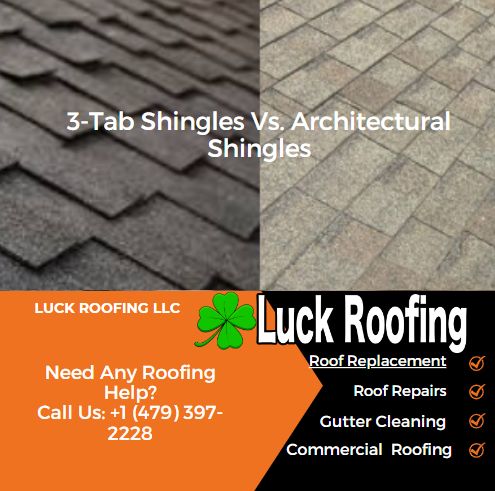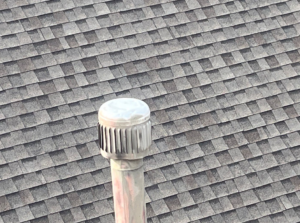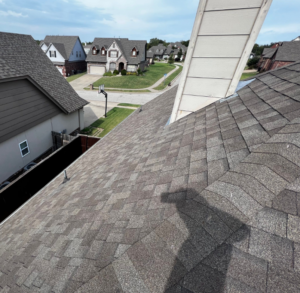Understanding the Distinction Between 3-Tab and Architectural Shingles

Selecting a new asphalt shingle roof entails making critical decisions, one of the most significant being the choice of shingle type.
For many homeowners, the decision often narrows down to two main options: 3-tab shingles and architectural shingles. To make an informed choice, it is essential to have a comprehensive comparison of the two.
With over three decades of experience, our team at Luck Roofing has been dedicated to assisting homeowners in selecting the optimal roofing material for their specific needs. It is our goal to provide you with the necessary information to facilitate an educated decision.
This article will begin by outlining the fundamental differences between 3-tab and architectural shingles, highlighting their advantages and disadvantages. Subsequently, we will compare the two in terms of aesthetic appeal, wind resistance, lifespan, warranties, and cost.
Understanding the distinction between 3-tab and architectural shingles is crucial for homeowners considering roof replacement or repair. Both types of shingles are manufactured from asphalt but differ significantly in design, durability, and aesthetic appeal.
Key Points In This Article
3-Tab Shingles:
-
- Flat asphalt roof shingles with three tabs of equal size.
- Single-layered, designed to lie flat on asphalt roofs.
- Uniform in size, shape, and color, providing a sleek look.
Laminated or Architectural Shingles:
-
- Made of multiple layers of asphalt, resembling tiles.
- Laminated shingles are highly resistant to hail and wind due to their dense layered build.
- They can withstand strong winds and intense weather conditions effectively.
- Easier to install compared to 3-Tab shingles.
- Preferred by roofers for durability and appearance.
- Variegated appearance adds interest to the home.
3-Tab Asphalt Shingles

Overview: 3-tab shingles are recognized for their uniform, flat appearance and are characterized by the three distinct cutouts or tabs along the lower edge, giving the illusion of three separate pieces. Historically, these shingles were the standard in residential roofing due to their affordability and straightforward installation process.
Advantages:
- Cost-Effectiveness: 3-tab shingles are among the most economical roofing materials available, making them an attractive option for homeowners on a tight budget.
- Ease of Installation and Repair: The simplicity of the 3-tab shingle design facilitates quick and efficient installation and repair, potentially reducing labor costs.
Disadvantages:
- Limited Lifespan: Compared to other roofing materials, 3-tab shingles have a shorter operational life, often requiring replacement sooner.
- Decreasing Availability: As the industry evolves, manufacturers are gradually phasing out 3-tab shingles in favor of more advanced options, which may affect availability for repairs and replacements.
- Color Matching Challenges: Finding an exact color match for repairs or partial replacements can be difficult, particularly as the product lines are reduced.
- Maintenance Requirements: To ensure longevity, 3-tab shingles necessitate regular maintenance, including annual inspections and potential repairs.
- Aesthetic Limitations: The uniform and flat appearance of 3-tab shingles offers limited curb appeal and may not enhance the architectural style of a home.
- Vulnerability to Environmental Damage: These shingles are more susceptible to damage from high winds and severe weather conditions, potentially leading to increased repair or replacement costs.
Popular Shingle Comparison Articles
Architectural Shingles Overview

Architectural shingles, often referred to as dimensional shingles, are a popular choice for homeowners seeking to enhance the aesthetic appeal of their roofs. These shingles are designed to offer a varied pattern that adds depth and simulates the appearance of traditional wood-shake roofs. Among asphalt shingle options, architectural shingles are notably prevalent, not just as a preferred choice for residential roofing but as a leading material in the roofing industry as a whole.
Benefits of Architectural Asphalt Shingles
-
Cost-Effectiveness: One of the primary advantages of architectural asphalt shingles is their affordability. When compared to other roofing materials, they offer a cost-efficient solution for homeowners looking for quality roofing without a significant financial investment.
-
Installation and Repair: Architectural asphalt shingles are known for their ease of installation and repair. This characteristic reduces labor costs and time, making it a practical choice for both new installations and roofing repairs.
-
Variety and Availability: There is a wide array of colors and styles available in architectural asphalt shingles, ensuring that homeowners can find options that best suit their aesthetic preferences and the architectural style of their homes. The widespread availability of these materials also means that replacements and repairs can be conducted without significant delays.
Challenges of Architectural Asphalt Shingles
-
Aesthetic Limitations: While architectural asphalt shingles can enhance the appearance of a roof, they may not offer the same level of curb appeal as some alternative materials, such as natural slate or cedar shakes. Homeowners desiring a more distinct or premium look might find architectural shingles somewhat limiting in this regard.
-
Maintenance Requirements: To maintain their condition and extend their lifespan, architectural asphalt shingles require regular maintenance. This typically involves annual inspections and maintenance tasks to address any wear or damage, ensuring the roof remains functional and attractive over time.
Now that you understand the primary distinctions between the two types of asphalt shingles, let’s dive into the heart of the matter. The remainder of this article will assess 3-tab and architectural shingles based on important factors such as appearance, wind resistance, warranty coverage, longevity, and pricing.
At Luck Roofing, we typically discourage the use of 3-tab shingles due to their poor wind rating. However, if a client has budget constraints, we would consider installing them, especially if they offer impact resistance and algae resistance comparable to Atlas Scotchgard warranty. We highly recommend considering Atlas Shingles for superior quality.
Popular Shingle Tile Types
Main Differences Between 3-tab shingles architectural shingles
Physical Composition
3-tab shingles and architectural shingles share a common base as both fall under the category of asphalt shingles. These shingles are manufactured using a blend of asphalt and adhesives, providing the necessary binding agents for structural integrity. Additionally, both variants incorporate granules on their outer layer for enhanced durability against weather elements. Furthermore, fiberglass is employed as a backing material, contributing to the shingles’ strength and stability.
However, while their fundamental composition remains similar, architectural shingles exhibit notable distinctions. Firstly, they boast a denser construction compared to their 3-tab counterparts. This denseness is reflected in their weight, with architectural shingles typically weighing about 50 percent more. The base mat of architectural shingles is notably thicker, offering heightened resilience against external pressures. Moreover, architectural shingles feature stronger adhesive properties, ensuring superior bonding and longevity. Additionally, the presence of a higher quantity of granules on the surface enhances their protective capabilities against UV radiation and other environmental factors. Furthermore, architectural shingles are crafted from asphalt of finer quality, denoting an elevated standard of material composition compared to 3-tab shingles. These combined attributes make architectural shingles a robust and long-lasting roofing solution suitable for various architectural needs.
Cost
Cost considerations are pivotal in any roofing decision, with affordability often influencing the choice between different roofing materials. While both 3-tab and architectural shingles are relatively affordable options, architectural shingles come at a higher initial cost compared to 3-tab shingles. On average, a 3-tab shingle roof costs around $4.00 per square foot, whereas an architectural shingle roof averages around $5.86 per square foot. However, it’s important to recognize that opting for cheaper roofing materials may result in higher expenses in the long run due to the need for frequent repairs and premature replacement. Therefore, investing in architectural shingles, despite the higher upfront cost, can ultimately lead to greater cost savings and long-term value by ensuring a durable and resilient roofing solution.
Lifespan
Roofing materials play a pivotal role in determining the longevity of a roof. While both asphalt shingles have relatively shorter lifespans compared to other roofing materials, architectural shingles have a distinct advantage in terms of durability. This is attributed to the superior quality of materials used in architectural shingles, enabling them to better withstand environmental factors over time. Proper installation and adequate attic ventilation are essential factors that contribute to maximizing the lifespan of architectural shingles, which typically range from 20 to 25 years. On the contrary, 3-tab shingles have a shorter lifespan, averaging between 15 to 20 years under optimal conditions. However, in regions prone to strong winds and frequent storms, the lifespan of 3-tab shingles may be even shorter, emphasizing the importance of choosing a roofing material that offers longevity and resilience.
Street and Curbside Appeal
The visual appeal of a roof significantly impacts the overall look of a house. When comparing 3-tab shingles and architectural shingles, it’s evident that architectural shingles offer superior curb appeal. Architectural shingles stand out due to their dimensional appearance, which adds depth and character to the roof. Unlike 3-tab shingles that lay flat and uniform, architectural shingles create a more dynamic and visually appealing surface. Additionally, architectural shingles offer a broader range of colors and styles, including options that mimic the rustic charm of cedar shakes. It’s worth noting that aesthetic preferences vary among homeowners, and some may still prefer the simplicity of 3-tab shingles.
Wind Ratings
The ability of a roof to withstand strong winds is crucial for its durability and structural integrity. In terms of wind resistance, architectural shingles outperform 3-tab shingles by a significant margin. This difference is primarily attributed to the thicker and higher-quality materials used in architectural shingles, as well as their unique installation method. For instance, Certainteed’s Landmark architectural shingles boast a remarkable 110-mph wind rating, whereas their XT25 3-tab shingles have a comparatively lower 60-mph wind rating. Moreover, by incorporating specific accessories, the wind rating of architectural shingles can be further increased to an impressive 130 mph, offering enhanced protection against severe weather conditions.
Warranties
The warranty provided with roofing materials reflects the manufacturer’s confidence in their product’s quality and durability. While both 3-tab and architectural shingles come with warranties, the disparity in their lengths underscores the discrepancy in their quality. Typically, 3-tab shingles offer a 25-year limited warranty, whereas architectural shingles provide a longer 30-year warranty, albeit prorated after 10 years. However, the standout feature of architectural shingles is the opportunity to obtain an enhanced 50-year non-prorated warranty. This enhanced warranty, achievable by utilizing all asphalt roofing components from a single manufacturer, offers comprehensive coverage for the entire lifespan of the materials. As such, architectural shingles emerge as the superior choice in terms of warranty coverage and long-term protection against potential roofing issues.
Home Resale Value
it’s crucial to consider the resale value of your home, whether you’re a long-time homeowner or in the market to sell or buy. Many newly constructed homes utilize 3-Tab Asphalt shingles, which are standard but less durable. If you’re aiming to enhance your home’s appeal before selling, opting for Laminated Shingles is highly recommended.
Upgrading to Laminated Shingles can significantly impact your home’s closing process. 3-Tab Asphalt shingles are prone to damage over time, which could lead to a lower appraisal during inspection. Laminated Shingles, on the other hand, offer greater durability, reducing the likelihood of inspection issues and potentially boosting your home’s value on the market.
Discovering the Perfect Fit for Your Home
The suitability of each of these shingle varieties is also relative. 3-tab shingles are more economical in the short term, so they may be ideal for rental properties and budget homes. Architectural shingles may be a better choice for high-end homes, as well as for homeowners who value aesthetics and longevity over lower initial costs. Here are some things to consider: Consider your climate. If you live in an area with severe weather, such as high winds or heavy snow, you may want to choose architectural shingles for their superior durability. Think about your budget. 3-tab shingles are typically less expensive than architectural shingles, but they may not last as long. If you are on a tight budget, 3-tab shingles may be a good option for you. Consider your aesthetic preferences. 3-tab shingles have a flat, uniform appearance, while architectural shingles have a more dimensional look. If you want your roof to have a more traditional appearance, 3-tab shingles may be a good choice. If you want your roof to have a more modern or upscale appearance, architectural shingles may be a better option. Get multiple estimates. Getting multiple estimates is a great way to ensure that you are getting a fair price for your roof replacement. It is also important to work with a local contractor who warranties their work. This will give you peace of mind knowing that your roof is protected in case there are any problems down the road.

Michael Overzat
Michael Overzat resides in Fort Smith, Arkansas with his wife and three kids. He enjoys to hike, skateboard, write, and get involved in charity organizations. He was originally born in Maryland. He has worked within the roofing industry for 5 years and is very active within the industry by attending conferences, masterminds, etc. His vision is to create a multi-state organization that has a customer centric model. He's worked for some of the biggest names in the industry and hopes to create a more people focused model for the roof replacement process.
